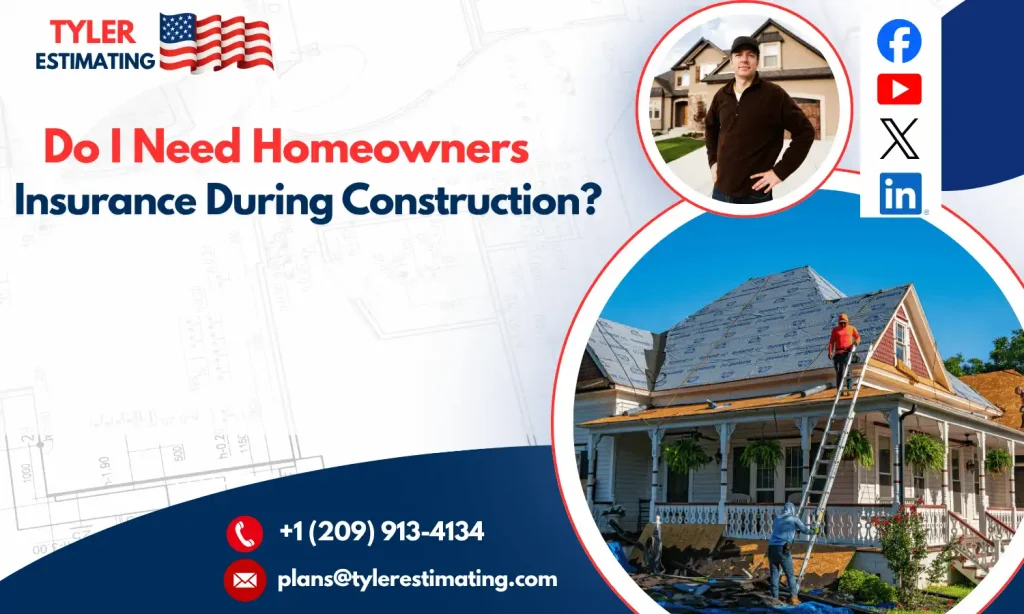Home construction or renovation is a very exciting experience, yet it is also a very risky process when it comes to the finances involved unless appropriate protection is provided. Homeowners are subjected to possible losses due to construction projects, including accidental damages, construction materials theft, weather-induced damages, and on-site injuries. The insurance of the house owners is important in the protection of the property and the investment during the construction period.
Nevertheless, conventional insurance policies may also be limited in covering some of these phases, leaving gaps that could be very expensive to cover. To respond to these risks, a lot of property owners resort to builder’s risk insurance or provide homeowners with endorsements to the already obtained policies. These are made to cover houses being built or those undergoing major renovations, so that the financial security is guaranteed in case of unforeseen circumstances. Proper insurance cover offers peace of mind and ensures the project through to completion.
In fact, many homeowners also consult xactimate estimating services to accurately assess potential repair or replacement costs during construction. This helps align the insurance coverage with realistic cost expectations, reducing the risk of being underinsured if damages or losses occur.
Why Insurance Is Necessary During Construction
Construction sites are likely to have risks that do not generally happen in finished homes. Half-constructed buildings are susceptible to fire, windstorms, vandalism, or materials theft. Without insurance, the expense of replacing stolen lumber, storm damage fix or injury expenses would be solely on the homeowner.
Construction Insurance Covers:
- Insurance against damage to property due to fire, storm, or accidents.
- Protection against theft or destruction of half-constructed materials or tools.
- Coverage against any claims brought by persons who may be injured on the premises.
- Security of knowing your investment is safe as long as the project goes on.
Homeowners Insurance vs. Builder’s Risk Insurance
Standard homeowners’ insurance is intended to cover finished occupied homes. When the major construction commences, most insurers demand a policy change or a separate policy of builder’s risk insurance.
Homeowners Insurance
- Premises occupied homes.
- May will not guarantee much protection in case of minor renovation.
- Usually will not cover a house that is empty or is doing extensive building work.
Builder’s Risk Insurance
- Particularly intended to be used in houses that are built or majorly renovated.
- Includes the structure, materials, and occasionally temporary structures such as scaffolding.
- Insures against fire, theft, vandalism, wind, hail, and some natural catastrophes.
- It can be bought by the homeowner, builder, or general contractor.
The majority of homeowners discover building risk policy to be the most preferred by a builder, as they are assured of coverage in construction.
What Builder’s Risk Insurance Covers
Although policies differ, builder risk insurance generally covers:
Structure Coverage: Covers work done on the partially built home, even work.
Building Materials: Covers an on-site material, in storage or in transit to the property.
Equipment and Tools: There are other policies that are extended to tools or rented equipment.
Temporary Structures: Scaffolding, fencing, or storage sheds coverage.
Debris Removal: Covers construction damage debris clean-up expenses in the event of a covered event.
What It Does Not Cover
It is also necessary to understand what is not included:
- Normal wear and tear.
- Workers’ Injuries of employees (workers’ compensation).
- Defective workmanship or mistakes in design.
- Unless specified individually, some natural disasters, such as earthquakes or floods.
Homeowners can be required to provide flood, earthquake, or extended liability endorsement to obtain complete protection.
Liability Coverage During Construction
Liability is another important factor, other than property damage. You may be liable to pay damages in case a worker, delivery person, or visitor is injured on your company’s construction site.
Homeowners are expected to make sure that:
- The subcontractors and builders are the ones with liability insurance.
- Workers are insured through workers’ compensation insurance.
- They both have personal liability cover under their own policy in case they are sued.
Lack of proper liability cover would open homeowners to thousands of dollars in lawsuits.
Costs of Insurance During Construction
Builder risk insurance is usually between 1 and 5 percent of the overall construction budget. An example is that a build of a car with a value of $200,000 could have a policy price of between $2,000 and $10,000.
Cost influencing factors include:
- Location of the property.
- Construction (wood or steel).
- Duration of the project.
- Limit on coverage and deductibles.
The cost might appear to be high, but financial protection is much more than a possible loss due to theft, fire, or extreme weather.
Who Buys the Policy: Homeowner or Contractor?
Builder’s risk insurance can be bought by both the builder and the homeowner. But it is necessary to explain this responsibility before construction.
- When it is purchased by the homeowner, he or she retains the policies and can guarantee that the coverage suits him.
- When the contractor purchases it, the homeowner should confirm details of coverage, but the total project cost can be part of the entire project cost.
Homeowners need to demand evidence of insurance and read the policy carefully, no matter who is buying it.
Renovations and Homeowners Insurance
In case you are performing a minor renovation, such as renovating a kitchen or building a small room, you might be covered in your current homeowners’ insurance policy. Nevertheless, you are also advised to inform your insurer to leave no gaps.
A builder’s policy of risk is normally needed during major renovations, i.e., when the building is to be changed structurally, enlarged, or completely rebuilt.
Lender Requirements
Most construction lenders will want builder’s risk insurance before they will release funds, should your project be funded via a construction loan. This guarantees that their investment will not be wasted in case there arises anything to the incomplete home.
The inability to demonstrate coverage may postpone or even cancel loan repayment.
Steps to Ensure Proper Coverage
- Contact Your Insurance Provider Early: Tell them you have a construction project and inquire about the coverage.
- Assess Your Risk: Take into account the extent of the project, place, and possible hazards.
- Compare Policies: Get quotes from many insurers to determine the best coverage and cost combination.
- Check Contractor Coverage: Check to establish that your builder is properly covered by liability and workers’ compensation insurance.
- Review Your Policy after Construction: After the house has been completed, revert to standard homeowners coverage at revised limits.
Conclusion
Yes, you most definitely require insurance when building. Normal homeowners’ insurance might not offer adequate coverage, particularly when carrying out extensive renovations or constructing new homes. Risk insurance for a builder is the most appropriate to protect your home, materials, and investment during the construction period.
Homeowners can be exposed to great financial risks in terms of theft of costly materials as well as liability for injuries on-site without proper coverage. With the proper policy in place, however, construction can proceed with an assured hand knowing that both the property and people are safe.
Construction insurance is not a luxury, but a necessity that anyone wishing to safeguard their home and future must have.




